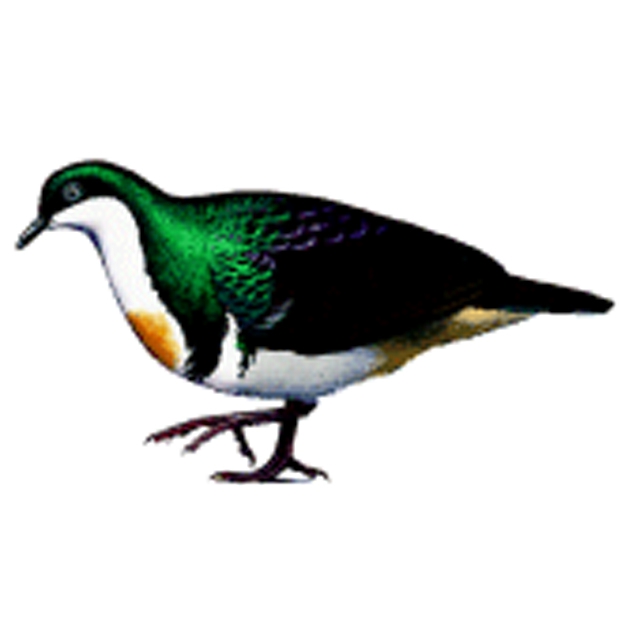| Citation |
BirdLife International. 2021. Gallicolumba menagei. The IUCN Red List of Threatened Species 2021: e.T22691005A203927952. https://dx.doi.org/10.2305/IUCN.UK.2021-3.RLTS.T22691005A203927952.en. Accessed on 02 May 2022. Brinkman, J.J., van der Ven, W., Allen, D., Hutchinson, R., Jensen, A.E., Perez, C. (2021): Checklist of birds of the Philippines. Wild Bird Club of the Philippines. www.birdwatch.ph |
Description |
JUSTIFICATION
This species has not been recorded with certainty since two specimens taken in 1891, and it may have declined severely through extensive logging and habitat destruction, compounded by hunting and trapping. However, it is perhaps unlikely to have gone extinct as there were local reports from a number of islands in 1995, and claims that it was quite abundant until the 1970s. Visits to Tawitawi in February and June 2009 did not produce any records of the species however (I. Sarenas per Sykes 2009), and conversations with trappers and other local people have failed to find anyone familiar with the species (R. Hutchinson in litt. 2012). Although disappearing fast, some habitat still remains. Any remaining population is likely to be tiny, and for these reasons it is treated as Critically Endangered.
RANGE DESCRIPTION
Gallicolumba menagei is endemic to the Sulu archipelago in the Philippines. It is known by just two specimens taken on Tawitawi in 1891, when it was described as extremely rare. The only evidence of its continued existence derives from unconfirmed local reports in 1995. Local reports claim that it was quite abundant before the 1970s, but had declined dramatically and is now only rarely seen. Visits to Tawitawi in February and June 2009 did not produce any records of the species (I. Sarenas per Sykes 2009), and conversations with trappers and other local people have failed to find anyone familiar with the species (R. Hutchinson in litt. 2012). Despite apparently being well-forested with secondary regrowth, Tandubatu, Dundangan and Baliungan have a total area of 17 km2, and are thought unlikely to support viable populations.
DESCRIPTION
The population is assumed to be tiny (fewer than 50 individuals and mature individuals) based on assessment of local reports and area of remaining habitat which concluded that the population must be extremely small and on the verge of extinction. Any extant population is likely to be declining in response to moderately rapid forest loss on Tawitawi. It is reliably known from just two specimens collected in 1891; there have been no confirmed records since and repeated surveys in the 1990s failed to find any direct evidence of the species.
Trend Justification: In 1994, most primary forest on the island of Tawitawi had been logged or cleared and only fragments remained, with proposals to convert some of those into oil-palm plantations. Between 2001 and 2020, forest loss on Tawitawi continued at a rate of c.0.7% per year, accelerating to c.1.4% between 2016-2020 (Global Forest Watch 2021). If this species is extant, any remnant population is may be in decline.
HABITAT AND ECOLOGY
Very poorly known. This species may be a small-island specialist. It may survive in logged forest, although its close relative G. keayi prefers primary forest (Allen 1998).
THREATS
In 1994, remaining primary forest on Tawitawi was being rapidly cleared and the areas of forest left were highly degraded and recently logged. In 1996, there were plans to replace even these with oil-palm plantations, and forest continues to be lost at a rate of c.1.4% per annum (2016-2020 trend; Global Forest Watch 2021) but in 2020 at least a few forest tracts remained. Logging of the few remaining tracts, now confined to rugged, mountainous areas, is ongoing. Small-scale logging operations occur on Tandubatu, Dundangan and Baliungan. No forest remains on the island of Jolo where there is a historic, unconfirmed report of the species (Baptista et al. 2020), although this record may refer to G. crinigera (Allen 2020). Hunting and trapping may have caused a substantial decrease during martial law in the 1970s.
USE AND TRADE
This species, if still extant, may be hunted.
CONSERVATION ACTIONS
Conservation Actions Underway
Military activity and insurgency continue to present a serious obstacle to general conservation activity in the Sulu islands. There are no protected areas in the archipelago. A proposal exists to provide conservation funding for the Tawitawi/Sulu Coastal Area, although neither the outcome nor the likely benefits to the species are known. In 1997, a public awareness campaign focusing on the conservation of terrestrial biodiversity on Tawitawi was initiated. In the mid-1990s, the species featured on a bilingual environmental awareness poster in the "Only in the Philippines" series.
Conservation Actions Proposed
Conduct intensive surveys of all remaining forest tracts on Tawitawi and other islands, such as those nearby as well as Sulu and Siasi for example, in order to establish whether the species is still extant. Urgently propose any sites found to support the species for strict protection. Incorporate protective measures relevant to this species within conservation funding proposals for the Tawitawi/Sulu Coastal Area, as and where appropriate. |

